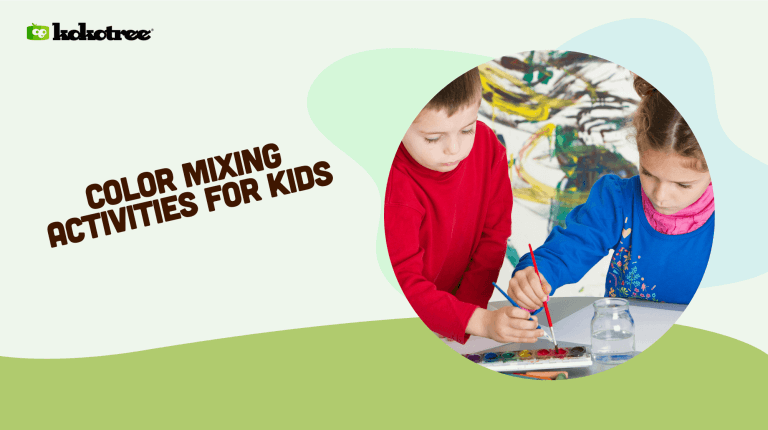

Introducing your little one to the world of colors can be both fun and educational. Color mixing, in particular, is a fascinating concept that allows children to learn about colors, experiment, and express themselves creatively.
These activities, including games, art projects, coloring pages, and experiments, make learning about colors engaging and enjoyable for kids. By participating in these color-mixing activities, toddlers can better understand colors, improve their motor skills, and spark creativity.
Freeze colored water in ice cube trays. Once frozen, let your preschooler mix them in a clear bowl and watch as the melting cubes create new colors. This activity encourages observation skills as children see solid ice transform into liquid and simultaneously change colors.
Using baking soda, food coloring, and vinegar, create mini volcanoes. When the vinegar is poured over, the eruption produces mixed colors. This activity teaches basic science principles alongside color mixing.
Let kids dip each hand in different paint colors and press them together to see a new color form. This tactile experience enhances hand-eye coordination and introduces the concept of primary and secondary colors.
Fill clear zip-lock bags with two different colors of hair gel or paint. Seal the bags and let the children squish them to mix the colors. It offers a mess-free way to understand color mixing while stimulating their sense of touch.
Fill a clear jar with layers of colored liquids (honey, dish soap, water, olive oil) and watch how they don’t mix. This visually appealing activity illustrates liquid density and the uniqueness of each color.
Use colored cellophane or transparent colored sheets over flashlights to explore how light can mix colors. Introduces the concept of light reflection and the difference between additive and subtractive color mixing.
Cut circles from transparent colored sheets and overlap them to show how colors blend. This simple color mixing activity for preschoolers visually teaches primary and secondary colors.
Let children drop watercolors onto wet paper towels and watch the colors spread and mix. It enhances fine motor skills and teaches about absorption and diffusion.
Place paper in a tray with drops of two paint colors and marbles. Tilt the tray and let the marbles roll through the paint. This dynamic activity not only teaches color mixing but also boosts motor skills.
Place colored water in two glasses and an empty one in the middle. Connect them with paper towels, watch the water ‘walk,’ and mix in the center glass—a great visual of capillary action and color fusion.
Mix water, dish soap, and food coloring. Whip it up to create colored foam, and let your child play and mix. It’s a sensory-rich color mixing activity for preschoolers that introduces them to texture.
Fill a clear glass with water, top it with shaving cream, and drop colored water onto the cream. Watch as it seeps through like rain. This shows how different mediums interact and create a mesmerizing visual effect.
Add drops of different food coloring to milk and then touch the surface with a cotton swab dipped in dish soap. The colors dance and mix. It’s a magical introduction to the science of molecules.
Let kids paint rocks with two colors and smear them together—mixing exploration that tactile color improves motor skills.
Tape three popsicle sticks together in a fan shape. Paint each stick a different color and twist them to mix—a DIY toy that teaches about color mixing and pattern creation.
Place paper and paint inside a salad spinner and spin to create mixed color patterns—a dynamic and playful introduction to centrifugal force and color combination.
Provide kids with primary colored playdough and let them combine portions to make new colors—a hands-on approach to understanding color properties and consistency.
Fill a zip-lock bag with two paint colors and tape it to a window. Let kids smudge and mix the colors. This fun, mess-free color mixing activity for preschoolers leverages natural light.
Create slimes of different colors and watch the magic as they mix and stretch. It’s a gooey, sensory-rich experience that’s always a hit with kids.
Fill two jars with different colored water. Use a turkey baster or pipette to transfer and mix colors. It enhances fine motor skills and teaches about liquid volumes.
Dip pieces of white yarn into different colored water and lay them crisscrossing on paper. Watch as the colors wick and blend. A textile-based exploration of color mixing that enhances dexterity.
Use colored transparent sheets to cast colored shadows. Overlap them to create mixed-color shadows—a playful introduction to light properties and shadow blending.
Rub two pieces of differently colored sidewalk chalks on the pavement to create mixed color streaks—an outdoor color mixing activity for preschoolers promoting physical activity.
Paint bubble wrap with two or more colors, press paper onto it, and reveal the mixed color patterns. This provides a fun textural experience and a unique art piece every time.
Place colored filters or plastic sheets over a white light source. Overlap different colors to see how they combine—an enlightening exploration of how filters can manipulate colors.
Embarking on these color mixing activities for preschoolers will surely make learning colors a memorable experience for your little one. By blending art and science, you’re fostering a well-rounded understanding of the world around them. Enjoy these colorful adventures together!




